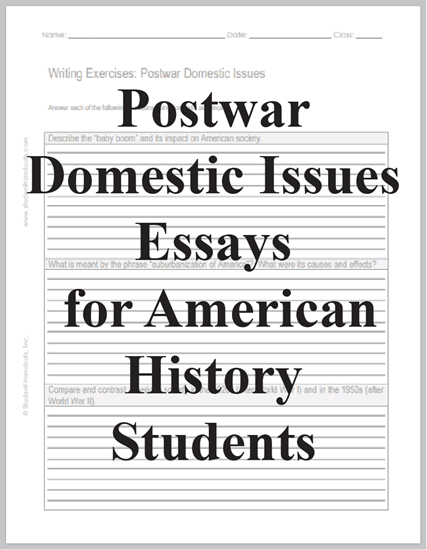1. Describe the “baby boom” and its impact on American society.
2. What is meant by the phrase “suburbanization of America”? What were its causes and effects?
3. compare and contrast American society in the 1920s (after World War I) and in the 1950s (after World War II).
Click
here to print (PDF). Answers will vary.
The "baby boom" was a significant demographic phenomenon that occurred in the United States and some other Western countries in the years following World War II, roughly between 1946 and 1964. It was characterized by a sudden and sustained increase in birth rates, resulting in a larger-than-average generation of babies. Here are the key aspects and the impact of the baby boom on American society:
Causes:
- Post-War Optimism: The end of World War II brought about an era of optimism and hope, and many couples decided to start families as they looked to the future with confidence.
- Returning Veterans: As American soldiers returned from overseas, they reunited with their spouses and started families.
- Economic Prosperity: The U.S. experienced a period of economic growth and prosperity during the post-war years, which made it more feasible for families to support children.
- Advancements in Healthcare: Improved medical care and healthcare facilities contributed to higher infant survival rates.
Key Features:
- Large Birth Cohort: The baby boom generation resulted in a notably large demographic cohort.
- Suburban Expansion: The increase in families and a desire for more space led to the expansion of suburban areas.
- Educational System Strain: Schools faced challenges accommodating the sudden increase in student populations.
- Cultural Impact: The baby boomers played a significant role in shaping American culture, music, and social movements in the 1960s and 1970s.
Impact on American Society:
- Economic Growth: The increased population of the baby boomers contributed to economic growth and expansion as they entered the workforce and became consumers.
- Educational Changes: The need to accommodate the baby boomer generation led to an expansion of educational infrastructure, including the construction of new schools and the hiring of more teachers.
- Cultural Influence: The baby boomers, as they came of age, had a profound impact on American culture. They were at the forefront of the civil rights movement, the anti-war protests, and the counterculture movements of the 1960s.
- Political Shifts: This generation also played a role in shaping American politics and policy, influencing various political movements and elections.
- Social Services: The increased demand for social services, including healthcare and retirement benefits, influenced government policies.
The baby boom had a profound and lasting impact on American society, affecting demographic patterns, cultural norms, the economy, and even politics. As this generation continues to age, it remains a significant force in American society and politics, with implications for healthcare, retirement, and various social issues.











